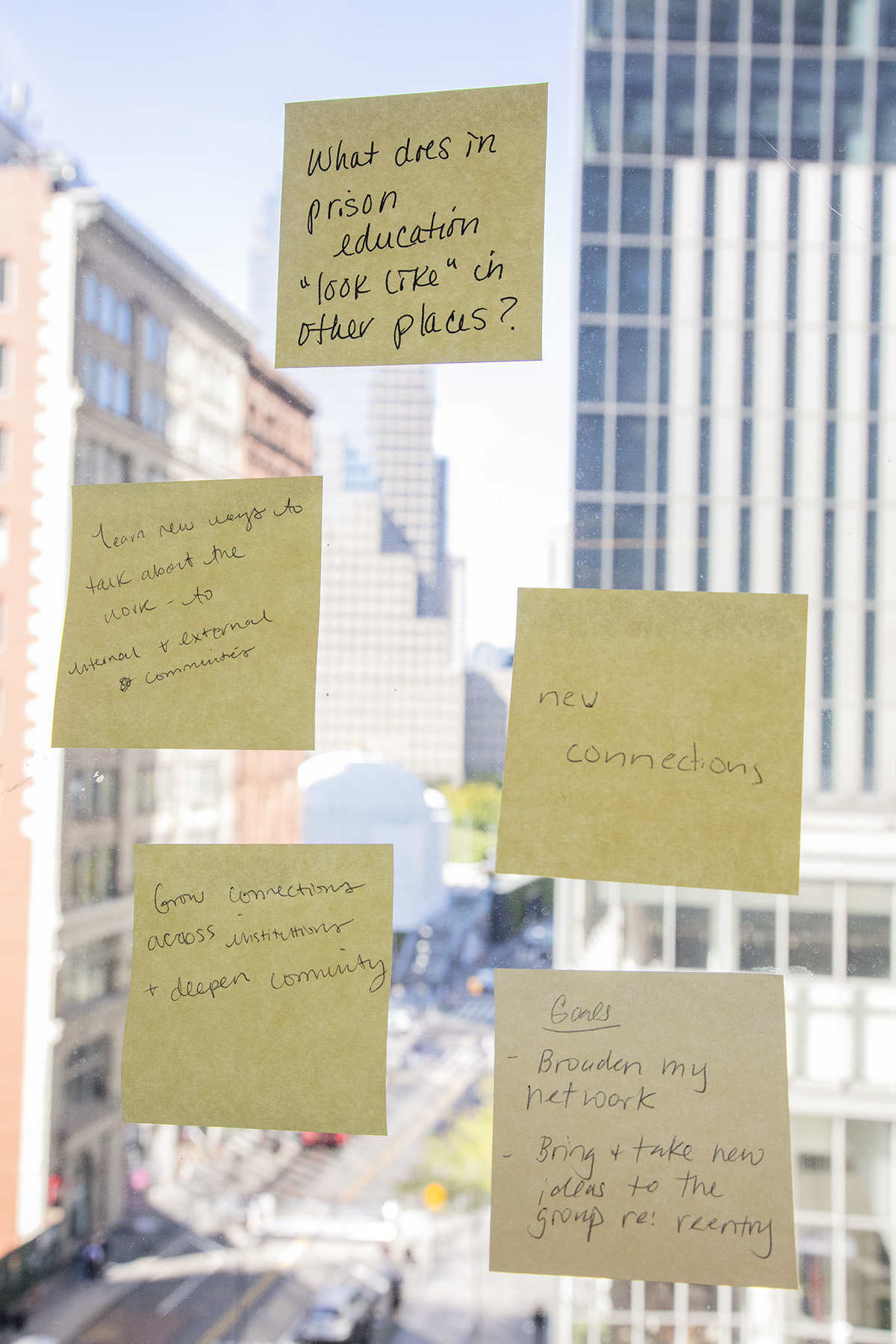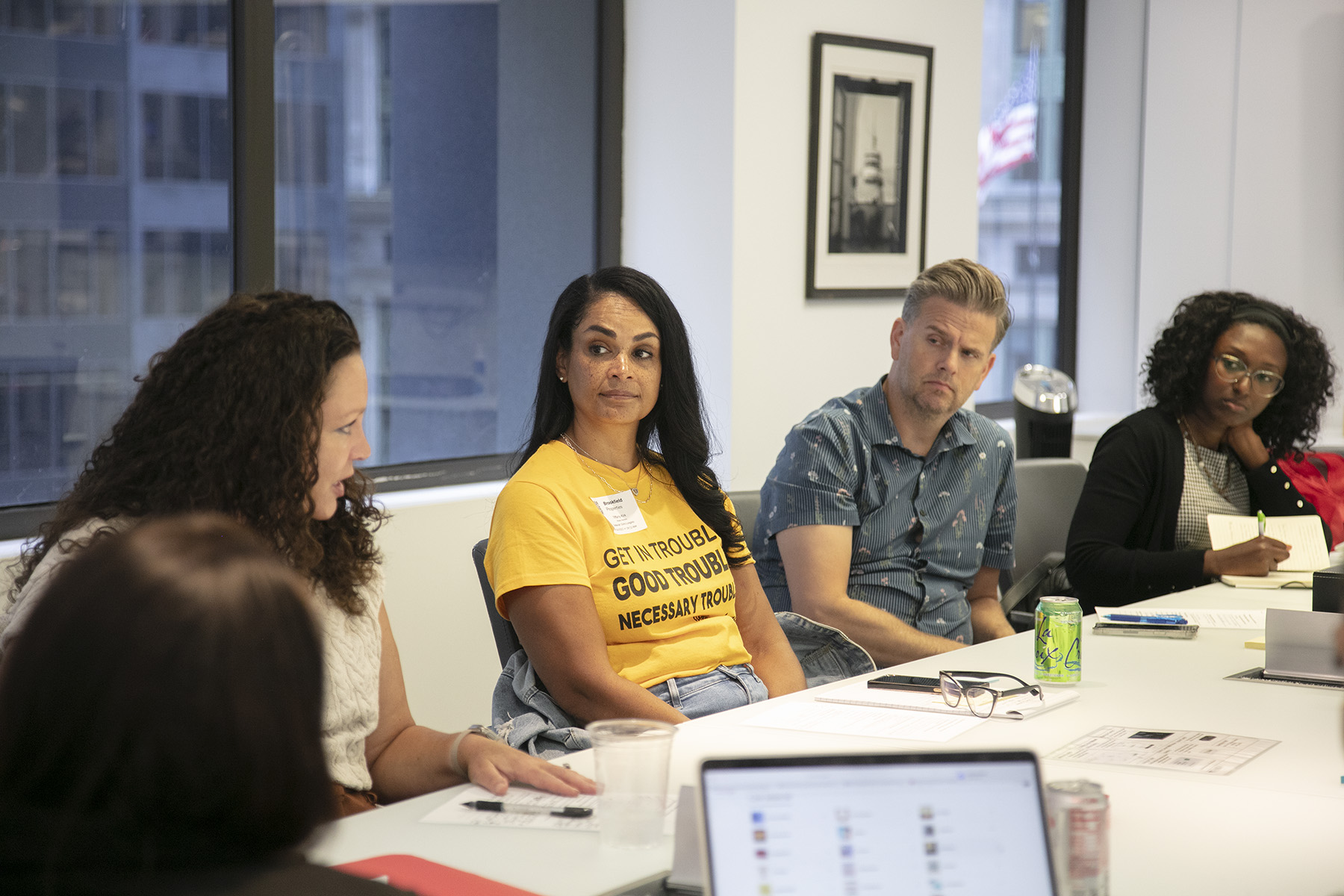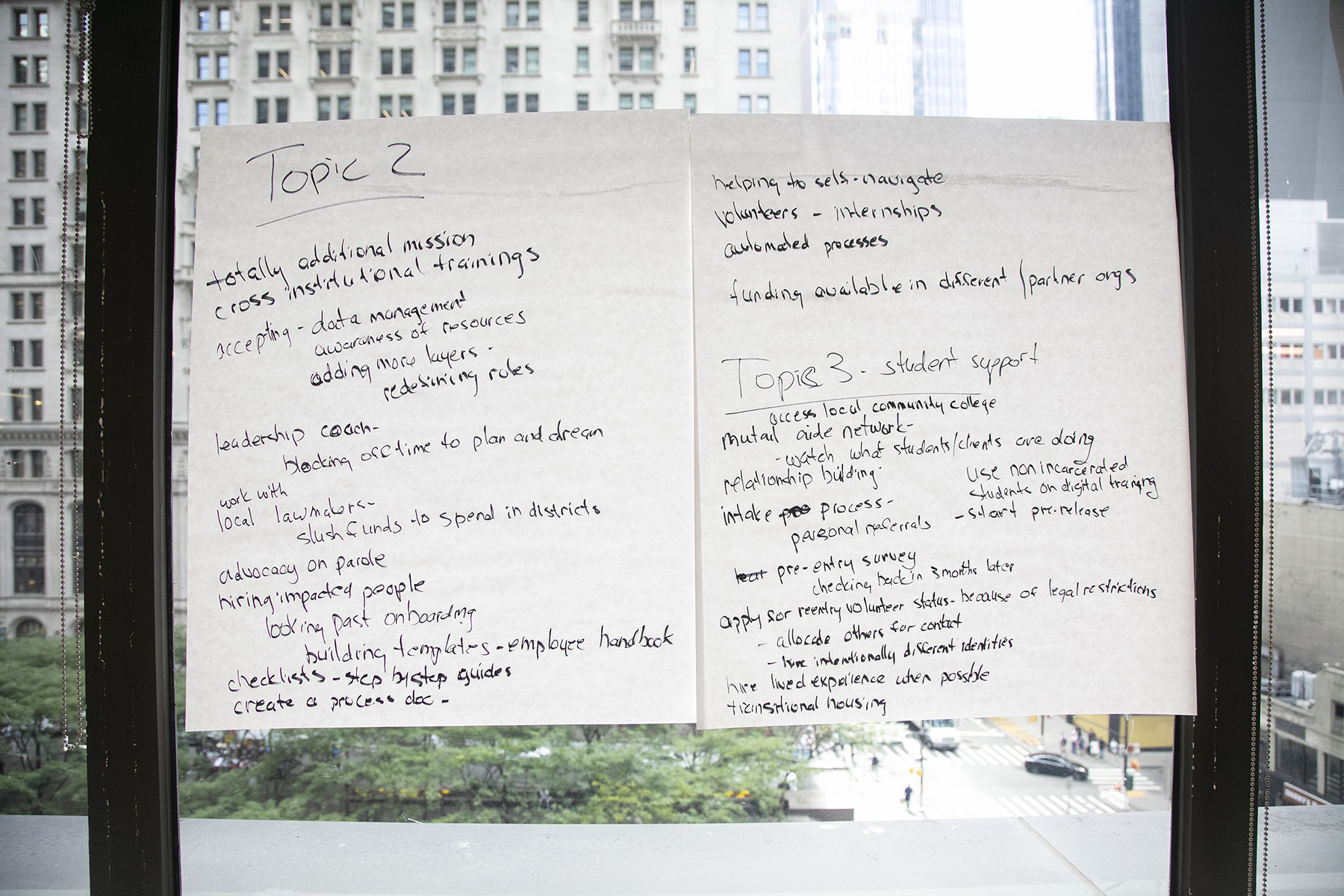Building College and Community Partnerships to Support Reentry
Updates from the Cohort
On September 25 and 26, Ithaka S+R hosted representatives from the programs and organizations taking part in its year-long cohort to build better college and community partnerships to support reentry, reintegration, and successful campus transitions for students who were incarcerated. This convening is part of a larger project funded by ECMC Foundation which has already produced a landscape review exploring how colleges and community organizations partner to serve reentry. The in-person event represents the mid-way point in the cohort phase of the project, and it marks a shift from identifying issues toward sharing and developing solutions.
This convening brought together representatives from the 10 college programs and 10 community-based organizations participating in a year-long cohort, exploring how college programs and community organizations can partner to serve reentering students. Recruitment prioritized active partnerships working in proximity—for example, the Utah Prison Education Program and Clean Slate Utah—and participants came from across the United States. We planned the activities of the day to move beyond problem identification to solution generation, from thought to action, and from Ithaka S+R-led sessions toward participant-owned sessions as the day went on.

Participants in lively conversation during a meal break. Artifacts from workshop exercises hang in the windows in the background.
What we learned together: preliminary takeaways
- Share what works. The dearth of publicly available and easily accessible information about how to develop, build, fund, and sustain partnerships and how to do so without straining programmatic or organizational capacity makes leaders feel like they need to reinvent the wheel. More repositories and community conversations are needed.
- Set shared expectations and develop shared vision. In participant-led sessions, program administrators and community organization leaders emphasized the importance of developing robust, multifaceted partnerships grounded in shared values and developing shared visions.
- Capacity and sustainability are driving concerns. Throughout the cohort phase, we have seen how higher education in prison programs, community organizations serving reentry needs, and campus programs supporting system impacted students all face similar challenges in having enough staff to do the work, systems and procedures to share knowledge, and long-term funding sustainability to keep programs operating.
- Community is key. The leaders of both community-based organizations and higher education in prison programs expressed the need and value of opportunities to interact with peers across the US.

Some of the intentions set by participants, with the view outside ITHAKA’s New York office as the backdrop.
What we did together
Building community and developing vulnerable dialogue: preparation and intention setting
In planning the event, we took special measures to ensure that participants had an active hand in shaping the structure and content of the day. Leading up to the event, we gave them an advance view of the agenda and allowed for feedback and invited participants to lead small workshops and facilitated discussions.
Before the event
In the months leading up to the convening, we met with representatives from the cohort to identify pressing needs related to reentry partnerships and reintegration services. During those calls, we discussed current challenges, possible opportunities, and the ways in which Ithaka S+R can provide support. These conversations uncovered overarching themes on persistent issues which we then used to frame the convening’s priority areas for workshops and sessions.
During the event
While participants finished their breakfast, we asked them to take a moment to set some intentions. We provided the following directions:
“As you start your day and settle into the space, please use the pen and sticky notes provided and jot down the following…
Anything you hope to do or accomplish together today
Anything you hope to take away from the convening
Please use a different sticky note for each idea/concept/response.”
We asked participants to place their sticky notes to the window so everyone could see the intentions being set by the group. We then asked participants to take some time to visit the windows and explore the intentions their peers were setting in a gallery walk.
When we officially started the event proceedings, one of the first things we did was return to these intentions. We highlighted some of the common responses—the bulk of which were about building community and connections in the work. Instead of moving from there directly into workshops, we took the time to collaboratively set community guidelines for the day.

We gave participants a few moments to think about how they might respond and asked for volunteers to share their responses as a way to foreground how we would come together and every single participant volunteered to share something. Before the formal workshops and activities had even really begun, we had established enough of a rapport that every participant joined in the conversation. This combination of intentional and active participation and open dialogue set the tone for the day and participants actively contributed, listened, took notes, and participated in exercises with diligence and care.

Convening participants in deep conversation. (From left to right the four individuals pictured in the foreground are Kerry Gant, Tiffany Kirk, Andrew Hundley, and Latiqua Washington.)
Moving toward action and relinquishing control: workshops, participant-led conversations, and guest speakers

An artifact from one of the four breakout rooms’ solution identification exercises.
We next moved into our first workshop activity of the day: Solution Identification. For this exercise, we randomly assigned participants into four groups and assigned one of four major overarching topics that we pre-identified from previous cohort activities to each group. The topics were 1) program mission, strategy, and collaboration; 2) infrastructure and capacity; 3) student support; and 4) funding and sustainability.
Each group reflected on common issues and challenges for their given topic and then wrote down as many potential solutions, mitigation strategies, or workarounds as they could imagine on individual sticky notes. The groups individually presented their solutions while visually sticking them in a shared space. We repeated the activity once or twice more, cycling through the other topics. The goal here was to shift the way we were thinking away from simply finding common ground and identifying common challenges or problems and toward generating solutions.
The second facilitated workshop dug deeper into this work and asked participants to move from identifying solutions to strategizing how to enact them. Participants self-selected into four strategic planning sessions centered around persistent issues previously identified in conversations with the cohort. The session topics included:
- Making the most of campus resources: setting plans to identify campus resources, partners, and collaborators
- Partners in thought and action: developing a shared mission and service vision
- Alleviating the pain: designing procedures and redundancies to improve communication and knowledge sharing
- Building a broader coalition: state CHEPS, regional organizations, and state agency partnerships
![“Roadmaps to streamline operations → look to different ecosystem actors with different models, standardization.” “Use platforms that are already designed to do things (e.g. payroll, onboarding, PTO [paid time off]) → Don’t reinvent from scratch what already works well.” “Process Documentation → creating the process to create processes (recovering loss of knowledge) → sol[ution] outline ta5trsk from beginning to end, talk through, link relevant docs.” “Checklists.”](https://sr.ithaka.org/wp-content/uploads/2025/10/image2-e1760630188674.jpg)
An artifact from the second set of workshops. These notes are from the discussion in workshop number three above, “Alleviating the Pain: Designing Procedures and Redundancies to Improve Communication and Knowledge Sharing.”
In the afternoon, participants led two sets of small-group sessions of either workshops or facilitated discussions. Across these sessions, practitioners, educators, and advocates explored strategies for supporting individuals with incarceration histories through institutional capacity-building, campus-based reentry initiatives, storytelling and record‑clearing, student voice empowerment, and cross‑sector partnerships—including data‑driven employer engagement and digital literacy efforts. Already primed to be constructive and solution-oriented by the morning’s activities, the participant-led sessions turned control of the day over to the cohort itself. This allowed people to make more individual connections in small group settings and to take the conversation where they found it helpful.
The final set of activities for the day was a series of guest speeches aimed at zooming the perspective out and putting our solution-oriented thinking in the broader context of college and community organization partnerships. In order to have folks end the day thinking about the broader context in which they work—and additional places they might find allies or better support reentering students—we turned to three esteemed guest speakers. Terrell A. Blount, the executive director of the Formerly Incarcerated College Graduates Network (FICGN) addressed alumni networks and community and provided an overview of FICGN’s work. Sarah Kuczynski, the director of the New England Prison Education Collaborative (NEPEC) and transfer initiatives at the New England Board of Higher Education (NEBHE) discussed the role of regional organizations in scaling and sustaining programmatic work and provided examples from NEPEC’s ongoing initiatives. Finally, Jonathan Reid, program officer at ECMC Foundation and this research project’s grant officer, spoke about the role and landscape of philanthropy in the field, providing examples and data from his work and the work of a broader philanthropic collective.
What comes next?
The final two remaining remote convenings will highlight the production of tools, templates, and learnings from our year working together. The goal of future convenings is to operationalize how college programs and community organizations can collaboratively support formerly incarcerated students’ reentry, reintegration, and the transition to campus outside.

A sticky note with “make new friends in the work” handwritten on it in pen, part of our intention setting exercise.
Special thanks
As this blog post likely indicates, the in-person convening was a major undertaking and we would like to offer public thanks to the people who made it possible.
Many, many thanks to our colleagues at Ithaka S+R who helped plan, organize, and facilitate the event: Deborah Longino, Grace Cope, Tommaso Bardelli, Juni Ahari, Martin Zapata, Fua Pan, and Donna Bona.
Thanks first to ECMC Foundation for supporting the larger project and making this event possible. Thanks to our guest speakers: Terrell A. Blount, Sarah Kuczynski, and Jonathan Reid. Special thanks to a few people who joined us in the work for the day: Kerry Gant, a co-founder of the Breaking Down Barriers Project and board member of the Center for Community Alternatives; Latiqua Washington the director of postsecondary access and success at Goddard Riverside Options Center; Elif Yucel an associate learning and evaluation officer at ECMC Foundation.
And thanks to all the individual representatives from participating colleges and organizations who made the trek to New York City to join us and those that were unable to, but who still contributed valuable observations throughout the project and before the event:
Brandeis Educational Justice Initiative
Center for Community Alternatives
Clean Slate Utah
Common Good Atlanta
Criminal Justice Ministry
Emerson Prison Initiative
Fresh Coast Alliance
Grand Valley State University
Louisiana Parole Project
Loyola at Rayburn
Morehouse College
North Carolina State University
Our Journey
Partakers
Petey Greene Program
Project Impact at BMCC
Thrive For Life
University of Rochester Education Justice Initiative (REJI)
Utah PEP
Washington University St. Louis PEP
Thanks also to the current members of our project advisory:
Avalon Betts-Gaston
Brandon Rodriguez
Brandon Warren
Taffany Lim
Tony Wallin-Sato
And many thanks to past advisory members, colleagues who offered support and advice, and you—the people out in the world, doing the work that our research and interventions serve.